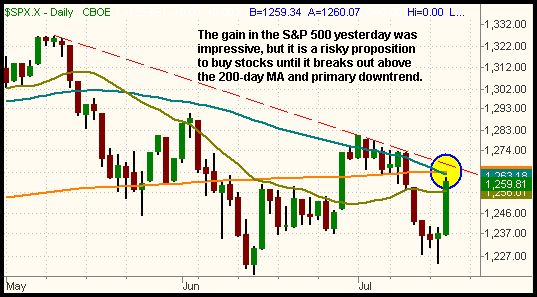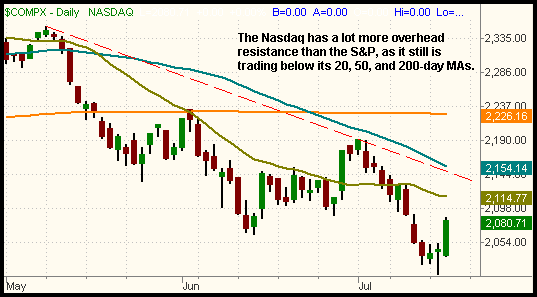As anticipated, stocks followed through on the previous session's reversal day, enabling the major indices to post solid gains across the board. The S&P 500 and Nasdaq Composite both rallied 1.8%, as the Dow Jones Industrial Average gained 2.0%. Small and mid-cap stocks, which typically lead the market in both directions, outperformed. The Russell 2000 Index surged 3.0% and the S&P 400 Mid-cap advanced 2.4%. Each of the major indices finished near their intraday highs, indicating the bears had no interest in selling into strength.
For the second day in a row, volume rose in both exchanges. Total volume in the NYSE was 8% higher, while volume in the Nasdaq was 16% higher than the previous day's level. The gains on higher volume marked the second consecutive "accumulation day," pointing to institutional buying interest. Market internals were also firmly positive. In the NYSE, advancing volume exceeded declining volume by a whopping margin of more than 12 to 1. However, the Nasdaq was positive by a ratio of only 3 to 1. The divergence in the market internals indicated broader-based strength in the S&P than the Nasdaq.
When the market rallies sharply off the lows, as it did yesterday, many novice traders and investors make the risky assumption that the market has bottomed and begin buying stocks. But doing so without taking a look at the "big picture" is a dangerous proposition. It's true that Tuesday's reversal day indicated a high probability that the market would follow through and rally the following day, but only traders with a very short time horizon would be wise to initiate new trades on the long side of the market. A lot of overhead supply remains and each of the major indices are still well below resistance of their primary downtrend lines. If the indices eventually break out above those downtrend lines, it would be less risky to be positioned net long, but that is not the case for now. The S&P 500 is still below both its primary downtrend line and its 200-day moving average, as the chart below illustrates:

If the S&P holds onto yesterday's gains and breaks out above the downtrend line illustrated above, we will begin testing the waters on the long side of the market, but astute traders will patiently wait for confirmation that would occur from a break of the downtrend line. In fact, many traders are viewing yesterday's rally as a chance to sell short on a bounce into resistance. Consider also that the Nasdaq Composite is still below its 20, 50, and 200-day moving averages. Obviously, each of those will act as major areas of resistance. Take a look:

We are smack in the middle of quarterly earnings season, which tends to make stocks more volatile than usual. After the close of trading, both eBay and Apple Computer reported earnings. Both were trading higher in the after hours market, which could help the major indices to build some upside momentum. But until we get confirmation, we are content to be positioned mostly in cash, waiting for the market to prove that it can sustain the gains that is has racked up. Professional traders know that the key to consistent long-term profitability is not found by being in the market all the time. On the contrary, most profitable traders will tell you they are out of the market more than they are in it. Remember that we are not in the business of gambling on which direction stocks will go. Rather, we simply react to price and volume patterns as they present themselves. If yesterday's rally is for real, there will be plenty of time to participate. However, jumping the gun without confirmation can be a costly proposition.
Deron Wagner is the Founder and Head Trader of both Morpheus Capital LP, a U.S. hedge fund, and Morpheus Trading Group, a trader education firm launched in 2001 that provides daily technical analysis of the leading ETFs and stocks. For a free trial to the full version of The Wagner Daily or to learn about Wagner's other services, visit MorpheusTrading.com or send an e-mail to deron@morpheustrading.com.